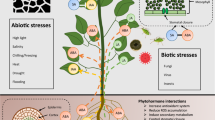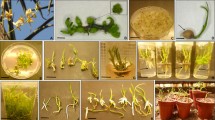Abstract
Encapsulation technology is a cost-effective method for conserving genetic resources, and it can provide a more stable environment so that plant materials can be stored for a longer period than with direct storage. However, the mechanism underlying this phenomenon is unknown. Therefore, in this study, we compared the hormone changes in encapsulated and nonencapsulated rhizomes stored in three different environments: 25 °C light, 25 °C dark, and 4 °C dark. A plant hormone analysis method based on the LC–MS/MS platform identified a total of 55 endogenous plant hormones distributed among six classes: ABAs, AXs, CKs, GAs, Jas, and SAs. PCA and HCA showed that the hormone profiles of rhizomes in different environments could be classified into three groups: the control group, encapsulation group, and nonencapsulation group. Compared with the control group, AXs (IAA-Asp and IAA-Glc), CKs (2MeScZR and K9G), and GAs (GA19 and GA53) decreased significantly, and ABAs (ABA-GE) and CKs (cZ9G, DZ and mT) increased significantly in all experimental groups. In addition, ABAs (ABA) and CKs (BAP) specifically decreased in the encapsulation group, while in the nonencapsulation group, CKs (BAPR) specifically decreased, and AXs (IAA-Ala) and CKs (tZOG) increased. Comparison of the encapsulation group and nonencapsulation group revealed that AXs (ICAld) and CKs (BAP and pT) specifically increased in the nonencapsulation group, while CKs (BAPR) and JAs (OPC-4 and JA) specifically increased in the encapsulation group. The current study obtained a comprehensive view of the hormone responses to various storage environments and improved our understanding of the mechanisms facilitating the longer storage of encapsulated tissues.







Similar content being viewed by others
Availability of data and material
The manuscript contains supplementary material available at sup.xlsx.
Abbreviations
- ABA(s):
-
Abscisic acid(s)
- ABA-GE:
-
ABA-glucosyl ester
- AX(s):
-
Auxins
- 2MeScZR:
-
2-Methylthio-cis-zeatin riboside
- BAP:
-
6-Benzyladenine
- IAA-Phe:
-
N-(3-Indolylacetyl)-L-phenylalanine
- IAA-Trp:
-
Indole-3-acetyl-L-tryptophan
- IAA-Val-Me:
-
Indole-3-acetyl-L-valine methyl ester
- ICA:
-
Indole-3-carboxylic Acid
- BAPR:
-
6-Benzyladenosine
- CK(s):
-
Cytokinins
- cZ9G:
-
Cis-Zeatin-9-glucoside
- cZR:
-
Cis-Zeatin riboside
- ICAld:
-
Indole-3-carboxaldehyde
- IP:
-
N6-isopentenyladenine
- IPR:
-
N6-isopentenyladenosine
- JA(s):
-
Jasmonic Acid(s)
- JA-ILE:
-
Jasmonoyl-L-isoleucine
- cZROG:
-
Cis-Zeatin-O-glucoside riboside
- JA-Phe:
-
N-[(-)-Jasmonoyl]-(l)-phenalanine
- DHZ7G:
-
Dihydrozeatin-7-glucoside
- JA-Val:
-
N-[(-)-Jasmonoyl]-(L)-valine
- DHZROG:
-
Dihydrozeatin-O-glucoside riboside
- K:
-
Kinetin
- DZ:
-
Dihydrozeatin
- K9G:
-
Kinetin-9-glucoside
- ET:
-
Ethylene
- LC–MS/MS:
-
Liquid chromatography tandem mass spectrometry
- GA(s):
-
Gibberellin(s)
- MEIAA:
-
Methyl indole-3-acetate
- GA15:
-
Gibberellin A15
- MEJA:
-
Methyl jasmonate
- GA19:
-
Gibberellin A19
- GA20:
-
Gibberellin A20
- NAA:
-
α-Naphthaleneacetic acid
- mT:
-
Meta-Topolin
- GA24:
-
Gibberellin A24
- OPC-4:
-
3-Oxo-2-(2-(Z)-Pentenyl) cyclopentane-1-butyric acid
- GA3:
-
Gibberellin A3
- OPDA:
-
Cis( +)-12-Oxophytodienoic acid
- GA53:
-
Gibberellin A53
- oT:
-
Ortho-Topolin
- HCA:
-
Hierarchical cluster analysis
- oT9G:
-
Ortho-Topolin-9-glucoside
- H2JA:
-
Dihydrojasmonic acid
- OxIAA:
-
2-Oxindole-3-acetic acid
- IAA:
-
Indole-3-acetic acid
- PCA:
-
Principal component analysis
- IAA- Ala:
-
N-(3-Indolylacetyl)-L-alanine
- pT:
-
Para-Topolin
- IAA-Asp:
-
Indole-3-acetyl-L-aspartic acid
- pT9G:
-
4-[[(9-Beta-D-Glucopyranosyl-9H-purin-6-yl) amino] methyl] phenol
- IAA-Glc:
-
1-O-indol-3-ylacetylglucose
- pTR:
-
Para-Topolin riboside
- IAA-Glu:
-
Indoleacetyl glutamic acid
- SA(s):
-
Salicylic acid(s)
- IAA-Gly:
-
Indole-3-acetyl glycine
- SAG:
-
Salicylic acid 2-O-β-Glucoside
References
Anis M, Ahmad N (2016) Plant tissue culture: propagation, conservation and crop improvement. Springer Nature, Singapore
Bari R, Jones JD (2009) Role of plant hormones in plant defence responses. Plant Mol Biol 69(4):473–488. https://doi.org/10.1007/s11103-008-9435-0
Chen J, Wu X, Yao X, Zhu Z, Xu S, Zha D (2015) Exogenous 6-benzylaminopurine confers tolerance to low temperature by amelioration of oxidative damage in eggplant (Solanum melongena L.) seedlings. Braz J Bot 39(2):409–416
Colebrook EH, Thomas SG, Phillips AL, Hedden P (2014) The role of gibberellin signalling in plant responses to abiotic stress. J Exp Biol 217(1):67–75. https://doi.org/10.1242/jeb.089938
Conway JR, Lex A, Gehlenborg N (2017) UpSetR: an R package for the visualization of intersecting sets and their properties. Bioinformatics 33(18):2938–2940. https://doi.org/10.1093/bioinformatics/btx364
Gantait S, Sinniah UR (2013) Storability, post-storage conversion and genetic stability assessment of alginate-encapsulated shoot tips of monopodial orchid hybrid Aranda Wan Chark Kuan ‘Blue’ × Vanda coerulea Grifft ex Lindl. Plant Biotechnol Rep 7(3):257–266
Gantait S, Bustam S, Sinniah UR (2012) Alginate-encapsulation, short-term storage and plant regeneration from protocorm-like bodies of Aranda Wan Chark Kuan ‘Blue’ × Vanda coerulea Grifft ex Lindl (Orchidaceae). Plant Growth Regul 68(2):303–311
Garcia-Mina JM (2012) Plant Nutrition and Defense Mechanism: Frontier Knowledge. In: Srivastava AK (ed) Advances in Citrus Nutrition. Springer, Netherlands, Dordrecht, pp 1–12
Ghaleh ZR, Sarmast MK, Atashi S (2020) 6-Benzylaminopurine (6-BA) ameliorates drought stress response in tall fescue via the influencing of biochemicals and strigolactone-signaling genes. Plant Physiol Biochem 155:877–887. https://doi.org/10.1016/j.plaphy.2020.08.009
Ghosh B, Sen S (1994) Plant regeneration from alginate encapsulated somatic embryos of Asparagus cooperi baker. Plant Cell Rep 13(7):381–385. https://doi.org/10.1007/BF00234142
Gomez RM, Dominguez-Sanchez MA, Sanchez MY, Barreto GE (2017) Neuroglial Cell Cryopreservation in Appropriate Inductive Conditions. Curr Pharm Des 23(28):4145–4153. https://doi.org/10.2174/1381612823666170816120044
Gupta S, Rashotte AM (2012) Down-stream components of cytokinin signaling and the role of cytokinin throughout the plant. Plant Cell Rep 31(5):801–812. https://doi.org/10.1007/s00299-012-1233-0
Ha S, Vankova R, Yamaguchi-Shinozaki K, Shinozaki K, Tran LS (2012) Cytokinins: metabolism and function in plant adaptation to environmental stresses. Trends Plant Sci 17(3):172–179. https://doi.org/10.1016/j.tplants.2011.12.005
Hare PD, Cress WA, van Staden J (1997) The involvement of cytokinins in plant responses to environmental stress. Plant Growth Regul 23(1):79–103. https://doi.org/10.1023/A:1005954525087
Havlova M, Dobrev PI, Motyka V, Storchova H, Libus J, Dobra J, Malbeck J, Gaudinova A, Vankova R (2008) The role of cytokinins in responses to water deficit in tobacco plants over-expressing trans-zeatin O-glucosyltransferase gene under 35S or SAG12 promoters. Plant Cell Environ 31(3):341–353. https://doi.org/10.1111/j.1365-3040.2007.01766.x
Hu L, Wang Z, Huang B (2013) Effects of cytokinin and potassium on stomatal and photosynthetic recovery of Kentucky bluegrass from drought stress. Crop Sci 53(1):221–231. https://doi.org/10.2135/cropsci2012.05.0284
Krouk G (2016) Hormones and nitrate: a two-way connection. Plant Mol Biol 91(6):599–606
Liberatore CM, Rodolfi M, Beghè D, Fabbri A, Ganino T, Chiancone B (2020) Adventitious shoot organogenesis and encapsulation technology in hop (Humulus lupulus L). Sci Hortic 270:109416
Liu Y, Zhang HL, Guo HR, Xie L, Zeng RZ, Zhang XQ, Zhang ZS (2017) Transcriptomic and Hormonal Analyses Reveal that YUC-Mediated Auxin Biogenesis Is Involved in Shoot Regeneration from Rhizome in Cymbidium. Front Plant Sci 8:1866. https://doi.org/10.3389/fpls.2017.01866
Manokari M, Latha R, Priyadharshini S, Jogam P, Shekhawat MS (2020) Short-term cold storage of encapsulated somatic embryos and retrieval of plantlets in grey orchid (Vanda tessellata (Roxb) Hook ex G Don). Plant Cell Tissue Org C (PCTOC). 144(1):171–183
Martin KP (2003) Clonal propagation, encapsulation and reintroduction of Ipsea malabarica (Reichb f) J D Hook, an endangered orchid. In Vitro Cell Dev Biol Plant 39(3):322–326
Miura K, Tada Y (2014) Regulation of water, salinity, and cold stress responses by salicylic acid. Front Plant Sci 5:4. https://doi.org/10.3389/fpls.2014.00004
Pandey GK (2017) Mechanism of plant hormone signaling under stress, 2, vol Set. John Wiley & Sons, New Delhi
Park HY, Kang KW, Kim DH, Sivanesan I (2018) In vitro propagation of Cymbidium goeringii Reichenbach fil through direct adventitious shoot regeneration. Physiol Mol Biol Plants 24(2):307–313
Qin F, Shinozaki K, Yamaguchi-Shinozaki K (2011) Achievements and challenges in understanding plant abiotic stress responses and tolerance. Plant Cell Physiol 52(9):1569–1582. https://doi.org/10.1093/pcp/pcr106
Rahman A (2013) Auxin: a regulator of cold stress response. Physiol Plant 147(1):28–35. https://doi.org/10.1111/j.1399-3054.2012.01617.x
Rai MK, Asthana P, Singh SK et al (2009) The encapsulation technology in fruit plants—A review. Biotechnol Adv 27:671–679. https://doi.org/10.1016/j.biotechadv.2009.04.025
Rivero RM, Kojima M, Gepstein A, Sakakibara H, Mittler R, Gepstein S, Blumwald E (2007) Delayed leaf senescence induces extreme drought tolerance in a flowering plant. Proc Natl Acad Sci 104(49):19631–19636. https://doi.org/10.1073/pnas.0709453104
Rodrigues V, Kumar A, Gokul S, Verma RS, Rahman Lu, Sundaresan V (2020) Micropropagation, encapsulation, and conservation of Decalepis salicifolia, a vanillin isomer containing medicinal and aromatic plant. In Vitro Cell Dev Biol Plant 56(4):526–537. https://doi.org/10.1007/s11627-020-10066-z
Rubio V, Bustos R, Irigoyen ML, Cardona-Lopez X, Rojas-Triana M, Paz-Ares J (2009) Plant hormones and nutrient signaling. Plant Mol Biol 69(4):361–373. https://doi.org/10.1007/s11103-008-9380-y
Saiprasad G, Polisetty R (2003) Propagation of three orchid genera using encapsulated protocorm-like bodies. In Vitro Cell Dev Biol Plant 39(1):42–48. https://doi.org/10.1079/IVP2002360
Tao J, Yu L, Kong F, Zhao D (2011) Effects of plant growth regulators on in vitro propagation of Cymbidium faberi Rolfe. Afr J Biotechnol 10(69):15639–15646
Vega A, Canessa P, Hoppe G, Retamal I, Moyano TC, Canales J, Gutierrez RA, Rubilar J (2015) Transcriptome analysis reveals regulatory networks underlying differential susceptibility to Botrytis cinerea in response to nitrogen availability in Solanum lycopersicum. Front Plant Sci 6:911. https://doi.org/10.3389/fpls.2015.00911
Wang J, Song L, Gong X, Xu J, Li M (2020) Functions of Jasmonic Acid in Plant Regulation and Response to Abiotic Stress. Int J Mol Sci 21(4):1146. https://doi.org/10.3390/ijms21041446
Werner T, Nehnevajova E, Kollmer I, Novak O, Strnad M, Kramer U, Schmulling T (2010) Root-specific reduction of cytokinin causes enhanced root growth, drought tolerance, and leaf mineral enrichment in Arabidopsis and tobacco. Plant Cell 22(12):3905–3920. https://doi.org/10.1105/tpc.109.072694
Xiaotao D, Yuping J, Hong W, Haijun J, Hongmei Z, Chunhong C, Jizhu Y (2012) Effects of cytokinin on photosynthetic gas exchange, chlorophyll fluorescence parameters, antioxidative system and carbohydrate accumulation in cucumber (Cucumis sativus L) under low light. Acta Physiol Plant 35(5):1427–1438
Xu ZY, Lee KH, Dong T, Jeong JC, Jin JB, Kanno Y, Kim DH, Kim SY, Seo M, Bressan RA, Yun DJ, Hwang I (2012) A vacuolar β-glucosidase homolog that possesses glucose-conjugated abscisic acid hydrolyzing activity plays an important role in osmotic stress responses in Arabidopsis. Plant Cell 24(5):2184–2199. https://doi.org/10.1105/tpc.112.095935
Yamaguchi-Shinozaki K, Shinozaki K (2006) Transcriptional regulatory networks in cellular responses and tolerance to dehydration and cold stresses. Annu Rev Plant Biol 57:781–803. https://doi.org/10.1146/annurev.arplant.57.032905.105444
Zwack PJ, Rashotte AM (2015) Interactions between cytokinin signalling and abiotic stress responses. J Exp Bot 66(16):4863–4871. https://doi.org/10.1093/jxb/erv172
Acknowledgements
This work was supported by Zhejiang province public welfare technology application research project (LGN19C150002).
Author information
Authors and Affiliations
Contributions
Fu designed and supervised this study. Fu performed the experiments and data analysis. Zhou, Yang, Ying, and Xu assisted in completing in vitro cultivation of plant materials. Fu wrote the manuscript.
Corresponding author
Ethics declarations
Conflict of interest
The authors have no conflict of interest to declare.
Ethics approval
Not applicable.
Consent to participate
Not applicable.
Consent for publication
Not applicable.
Additional information
Handling Editor: Stephen Werbrouck.
Publisher's Note
Springer Nature remains neutral with regard to jurisdictional claims in published maps and institutional affiliations.
Supplementary Information
Below is the link to the electronic supplementary material.
Rights and permissions
About this article
Cite this article
Fu, S., Zhou, Z., Yang, Y. et al. Hormonal Profiling of Encapsulated and Nonencapsulated Rhizomes of Chinese Cymbidium in Different Storage Environments. J Plant Growth Regul 42, 1006–1016 (2023). https://doi.org/10.1007/s00344-022-10609-1
Received:
Accepted:
Published:
Issue Date:
DOI: https://doi.org/10.1007/s00344-022-10609-1




